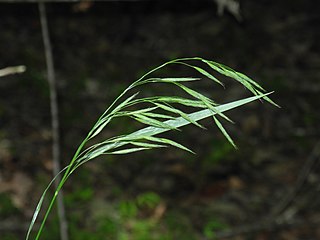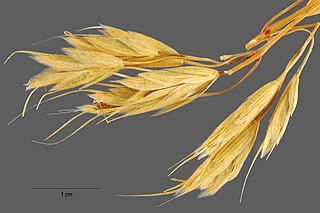
Bromus arvensis, the field brome, is a brome grass native to Europe and Asia. The specific epithet arvensis is Latin, meaning "of cultivated land".

Bromus hordeaceus, the soft brome, is an annual or biennial species of grass in the grass family (Poaceae). It is also known in North America as bull grass, soft cheat, and soft chess.

Festuca occidentalis is a species of grass known as western fescue. It is native to much of the northern half of North America and is most widely distributed in the west. It is most often found in forest and woodland habitat. The specific epithet occidentalis is Latin, meaning "western".

Bromus catharticus is a species of brome grass known by the common names rescuegrass, grazing brome, prairie grass, and Schrader's bromegrass. The specific epithet catharticus is Latin, meaning cathartic. The common name rescuegrass refers to the ability of the grass to provide forage after harsh droughts or severe winters. The grass has a diploid number of 42.

Bromus kalmii, the Arctic brome or prairie brome, is a species of brome grass. It is a native bunchgrass in the North-central and Northeastern United States, the Great Lakes region, and eastern Canada. The specific epithet kalmii refers to its discoverer Pehr Kalm.
Melica argyrea is a species of grass found in Argentina, Brazil, and Uruguay.
Melica animarum is a species of grass that is endemic to Sierra de las Ánimas in Uruguay.
Melica brasiliana, is a grass species in the family Poaceae that is endemic to Brazil and southern South America.
Melica tibetica, is a grass species in the family Poaceae that is endemic to China and can be found in such provinces as Inner Mongolia, Qinghai, Sichuan, and Tibetan Autonomous Region.
Melica hyalina is a species of grass found in Brazil and southern South America.

Melica penicillaris is a species of grass in the Poaceae family. It is endemic to Inner Anatolia, Turkey, where it grows on bushy hills, rocky slopes, limestone surfaces, and in gullies at 1,000–1,800 metres (3,300–5,900 ft) above sea level.

Bromus nottowayanus, the Nottoway Valley brome or satin brome, is a brome grass native to North America. The specific epithet nottowayanus refers to the Nottoway Valley. The grass has a diploid number of 14.

Bromus japonicus, the Japanese brome, is an annual brome grass native to Eurasia. The grass has a diploid number of 14.

Bromus squarrosus, the rough brome, is a brome grass native to Russia and Europe. The specific epithet squarrosus is Latin, meaning "with spreading tips". The grass has a diploid number of 14.

Festuca brachyphylla, commonly known as alpine fescue or short-leaved fescue, is a grass native to Eurasia, North America, and the Arctic. The grass is used for erosion control and revegetation. The specific epithet brachyphylla means "short-leaved". The grass has a diploid number of 28, 42, or 44. This species was first described in 1827.

Festuca saximontana, the rocky mountain fescue or the mountain fescue, is a perennial grass native to North America. The specific epithet saximontana is Latin and means "of the Rocky Mountains". The grass has a diploid number of 42.

Puccinellia fasciculata, or Borrer's saltmarsh grass, is an annual grass native to coasts of Europe and introduced to the northern east coast of North America. Its diploid number is 28.
Glyceria acutiflora, the creeping mannagrass, is a perennial grass found in the north-eastern United States and in north-eastern Asia. Its specific epithet acutiflora means "acute-flowered". It has a diploid number of 40.

Glyceria melicaria, the melic mannagrass or northeastern mannagrass, is a perennial grass found in the eastern United States. Its specific epithet melicaria means "similar to Melica". Its diploid number is 40.

Sphenopholis intermedia, the slender wedgegrass or slender wedgescale, is an annual grass native to North America. The specific epithet "intermedia" means "intermediate". The diploid number is 14.














